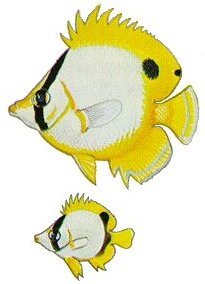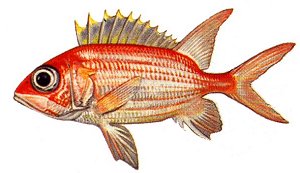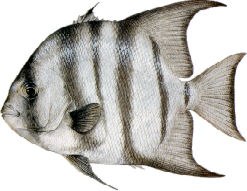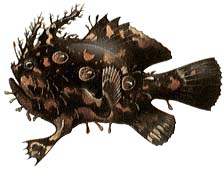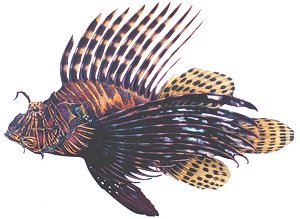Chaetodon ocellatus
Size: juveniles 1-2"; adults to 6"
Habitat: inlets and rivers, late in the season
Notes: The adult fish is shown above, the juvenile below.
The best time to view or capture these fishes is at night when they are asleep. During the day they are wary and very quick. Nighttime coloration is completely different from daytime - dark vertical bars and blotches over the entire body.
More: Spotfin Butterflyfish ...
Holocentrus adscensionis
Size: to 12"
Habitat: inlets and rivers, late in the season
Notes: Squirrelfishes are nocturnal - the enormous eye is a dead giveaway. Look for small ones at night in the late summer and early fall in the rivers and inlets. Unfortunately, they are rare visitors to our area.
More: Squirrelfish ...
Chaetodipterus faber
Size: to 36" and 20 lbs.
Habitat: shallow coastal waters
Notes: Spadefishes are not quite as tropical as the others on this page, and typically range to New England. They may form large schools. Babies are uniformly black without stripes.
More: Atlantic Spadefish ...
Histrio histrio
Size: to 6"
Habitat: wherever the current takes them
Notes: Sargassum fishes are found in drifting clumps of Sargassum weed. They are certainly one of the most bizarre fishes you may encounter. Their closest relatives are deep-sea anglerfishes and the local Goosefish. The paired fins are used exactly like arms and legs, and the Sargassum fish is a clumsy and reluctant swimmer. In fact, the pectoral (arm) fins can be folded over below the elbow, giving the fish an opposable grasp much like our own hands!
More: Sargassum Fish ...
Pterois volitans
Size: to 17", usually smaller
Habitat: turning up all along the East Coast
Notes: venomous spines
This Indo-Pacific scorpionfish has been sighted in the wild in Florida and the Caribbean since the 1990s. In 2000 it began appearing off North Carolina. Two juveniles were found off Long Island in 2002, and in 2003 a two-inch yearling was collected in the Shark River. Of course, this popular pet is sighted daily in public and private aquariums all over the world.
More: Lionfish ...

